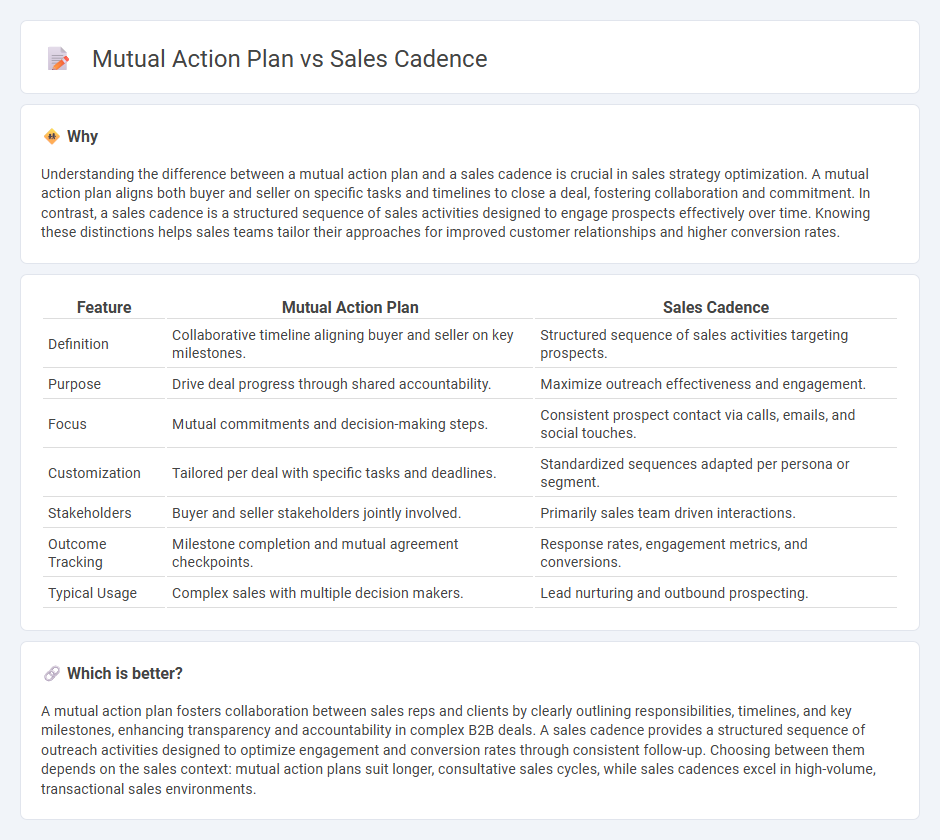
A mutual action plan outlines collaborative steps and timelines agreed upon by both the sales team and the buyer to ensure aligned progress toward closing a deal. In contrast, a sales cadence refers to the structured sequence of sales activities and communications a salesperson follows to engage prospects and move them through the sales funnel. Discover the key benefits and strategic uses of each approach to enhance your sales effectiveness.
Why it is important
Understanding the difference between a mutual action plan and a sales cadence is crucial in sales strategy optimization. A mutual action plan aligns both buyer and seller on specific tasks and timelines to close a deal, fostering collaboration and commitment. In contrast, a sales cadence is a structured sequence of sales activities designed to engage prospects effectively over time. Knowing these distinctions helps sales teams tailor their approaches for improved customer relationships and higher conversion rates.
Comparison Table
| Feature | Mutual Action Plan | Sales Cadence |
|---|---|---|
| Definition | Collaborative timeline aligning buyer and seller on key milestones. | Structured sequence of sales activities targeting prospects. |
| Purpose | Drive deal progress through shared accountability. | Maximize outreach effectiveness and engagement. |
| Focus | Mutual commitments and decision-making steps. | Consistent prospect contact via calls, emails, and social touches. |
| Customization | Tailored per deal with specific tasks and deadlines. | Standardized sequences adapted per persona or segment. |
| Stakeholders | Buyer and seller stakeholders jointly involved. | Primarily sales team driven interactions. |
| Outcome Tracking | Milestone completion and mutual agreement checkpoints. | Response rates, engagement metrics, and conversions. |
| Typical Usage | Complex sales with multiple decision makers. | Lead nurturing and outbound prospecting. |
Which is better?
A mutual action plan fosters collaboration between sales reps and clients by clearly outlining responsibilities, timelines, and key milestones, enhancing transparency and accountability in complex B2B deals. A sales cadence provides a structured sequence of outreach activities designed to optimize engagement and conversion rates through consistent follow-up. Choosing between them depends on the sales context: mutual action plans suit longer, consultative sales cycles, while sales cadences excel in high-volume, transactional sales environments.
Connection
A mutual action plan aligns sales teams and clients on specific steps, timelines, and responsibilities to drive deal progression, while a sales cadence structures the timing and frequency of communication throughout the sales process. Together, they ensure coordinated engagement, maximize client touchpoints, and enhance forecast accuracy by maintaining consistent momentum. Integrating these elements streamlines collaboration and accelerates revenue generation by keeping all stakeholders accountable and informed.
Key Terms
**Sales Cadence:**
Sales cadence is a structured sequence of sales activities designed to engage prospects through calls, emails, and social touches aimed at nurturing leads and closing deals efficiently. It leverages timing, frequency, and messaging strategies to maximize response rates and accelerate the sales cycle. Explore how implementing a tailored sales cadence can enhance your sales performance and customer engagement.
Touchpoints
Sales cadence emphasizes the timing and frequency of touchpoints to systematically engage prospects and drive conversions, focusing on multi-channel communication like calls, emails, and social media interactions. Mutual action plans center on collaborative touchpoints between sales and buyers, outlining agreed-upon milestones and responsibilities to ensure alignment and accelerate deal closure. Explore how optimizing touchpoints in both strategies can enhance sales effectiveness and customer engagement.
Sequence
Sales cadence emphasizes a structured sequence of outreach activities designed to engage prospects consistently and efficiently, often integrating calls, emails, and social media touchpoints. In contrast, a mutual action plan outlines a collaborative sequence of agreed-upon steps between buyer and seller to achieve deal closure, focusing on alignment and accountability. Explore detailed strategies to optimize your sales sequence for improved engagement and deal success.
Source and External Links
5 Winning Sales Cadence Examples - Callbox - A sales cadence is a scheduled sequence of touchpoints--calls, emails, LinkedIn messages, and more--used to engage a lead or prospect over time, with example sequences showing how to mix channels and timing for effective outreach.
What is a Sales Cadence? - DealHub - A sales cadence is a systematic sequence of outreach activities (social media, email, phone) that sales reps use to consistently nurture leads and build relationships, with specific examples for inbound leads emphasizing quick response and personalized follow-up.
What is a Sales Cadence? - Revenue.io - A sales cadence is a pre-determined, scheduled series of sales activities (calls, texts, emails, social messages) following a set order and timing to maximize prospect engagement during sales campaigns.
 dowidth.com
dowidth.com